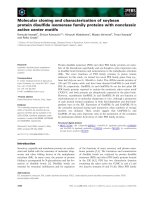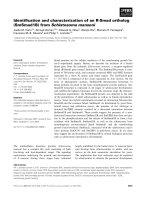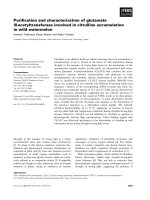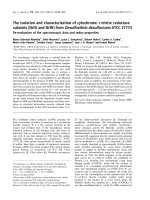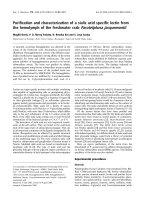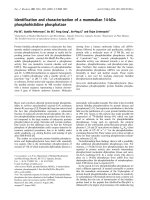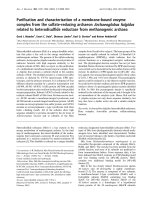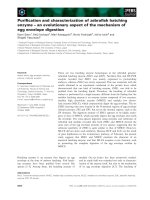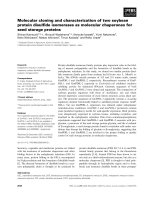Báo cáo khoa học: cDNA cloning and characterization of a novel calmodulinlike protein from pearl oyster Pinctada fucata potx
Bạn đang xem bản rút gọn của tài liệu. Xem và tải ngay bản đầy đủ của tài liệu tại đây (473.33 KB, 12 trang )
cDNA cloning and characterization of a novel calmodulin-
like protein from pearl oyster Pinctada fucata
Shuo Li
1
, Liping Xie
1,2
, Zhuojun Ma
1
and Rongqing Zhang
1,2
1 Institute of Marine Biotechnology, Department of Biological Sciences and Biotechnology, Tsinghua University, Beijing, China
2 Protein Science Laboratory of the Ministry of Education, Tsinghua University, Beijing, China
The shells of bivalve molluscs, especially the internal
lustrous ‘mother of pearl’ layer of the shell, with
exceptional nanoscale architectures and outstanding
mechanical performance, have received a great deal of
attention from many biology and materials scientists
in the past few decades [1]. Shells and pearls are all
products of calcium metabolism which is a very
complicated and highly controlled physiological and
biochemical process. The oyster calcium metabolism
involves calcium ion absorption, transport, accumula-
tion, secretion, deposition and other important steps.
Investigations have mainly focused on purification of
matrix proteins, the end products of oyster calcium
metabolism. However, how calcium is transported into
the cell, is secreted from the mantle epithelium, and
how the calcium carbonate crystals are formed remain
unclear. In particular, what regulatory factors are
involved in these processes is obscure. Recent observa-
tions indicate that hemocytes may be directly involved
in shell crystal production in oyster [2].
CaM is a ubiquitous eukaryotic calcium sensor pro-
tein that mediates many important signaling pathways
Keywords
Calmodulin; calmodulin-like protein; calcium;
oyster; Pinctada fucata
Correspondence
R. Zhang, Department of Biological Sciences
and Biotechnology, Tsinghua University,
Beijing 100084, China
Fax: +86 10 62772899
Tel: +86 10 62772899
E-mail:
Note
The nucleotide sequence reported in this
paper has been submitted to GenBank with
the accession number AY663847
(Received 26 May 2005, revised 14 July
2005, accepted 3 August 2005)
doi:10.1111/j.1742-4658.2005.04899.x
Calcium metabolism in oysters is a very complicated and highly controlled
physiological and biochemical process. However, the regulation of calcium
metabolism in oyster is poorly understood. Our previous study showed that
calmodulin (CaM) seemed to play a regulatory role in the process of oyster
calcium metabolism. In this study, a full-length cDNA encoding a novel
calmodulin-like protein (CaLP) with a long C-terminal sequence was identi-
fied from pearl oyster Pinctada fucata, expressed in Escherichia coli and
characterized in vitro. The oyster CaLP mRNA was expressed in all tissues
tested, with the highest levels in the mantle that is a key organ involved in
calcium secretion. In situ hybridization analysis reveals that CaLP mRNA
is expressed strongly in the outer and inner epithelial cells of the inner
fold, the outer epithelial cells of the middle fold, and the dorsal region of
the mantle. The oyster CaLP protein, with four putative Ca
2+
-binding
domains, is highly heat-stable and has a potentially high affinity for cal-
cium. CaLP also displays typical Ca
2+
-dependent electrophoretic shift,
Ca
2+
-binding activity and significant Ca
2+
-induced conformational chan-
ges. Ca
2+
-dependent affinity chromatography analysis demonstrated that
oyster CaLP was able to interact with some different target proteins from
those of oyster CaM in the mantle and the gill. In summary, our results
have demonstrated that the oyster CaLP is a novel member of the CaM
superfamily, and suggest that the oyster CaLP protein might play a differ-
ent role from CaM in the regulation of oyster calcium metabolism.
Abbreviations
CaM, calmodulin; CaLP, calmodulin-like protein; CD, circular dichroism; EGTA, ethylene glycol-bis-(b-amino-ethyl ether)N,N,N¢,N¢-tetra-acetic
acid; RACE, rapid amplification of cDNA ends; UTR, untranslated region.
FEBS Journal 272 (2005) 4899–4910 ª 2005 FEBS 4899
regulating several crucial processes such as secretion,
cyclic nucleotide metabolism, cellular calcium meta-
bolism, muscle contraction, glycogen metabolism, cell
proliferation and differentiation, and gene expression
(reviewed in [3–8]). Noticeably, two CaM-regulated
calcium metabolism components, Ca
2+
-ATPase and
Ca
2+
channels, have been suggested to be involved in
the calcification process in some marine invertebrates
[9–14]. In addition, recent lines of evidence also
demonstrate that CaM plays an important role in
regulating the function of mature osteoclasts and osteo-
clastogenesis, a bone biomineralization related process
[15]. CaM-like protein as a multifunctional calcium
sensor belongs to a new member of CaM superfamily,
which has been found in bacteria [16], nematode [17],
Drosophila [18], plant [19], chicken [20,21], rat [22] and
human [23–25]. In human beings, CaLP proteins are
involved in epithelial cell differentiation [25,26]. Recent
studies showed that CaLP proteins were able to regu-
late the Ca
2+
-induced Ca
2+
release in rat and human
cell lines [27]. Sidhu and Guraya have reported that
CaLP might be involved in calcium transport in buf-
falo sperm [28].
Our previous study reveals that oyster CaM mRNA
is expressed highest in gill [29] that is a key organ
involved in calcium ion uptake, and is also strongly
expressed in the epithelial cells at the folds and the
outer dorsal region of the mantle. These observations
suggest that CaM may be actively involved in the regu-
lation of calcium transport and secretion in oyster.
The complicated oyster calcium metabolism process
might exist in more factors that also participate in the
many critical steps of calcium metabolism, including
the transport of the extracellular calcium ions to the
mantle epithelium where the calcium is deposited onto
the organic framework formed mainly by matrix pro-
teins. Identification of more regulatory factors involved
in the complicated process will not only provide crit-
ical clues to the understanding of the underlying mech-
anism of calcium metabolism in the process of shell
and pearl formation, but also offer the opportunity to
promote the yield and quality of pearl. In this study,
we isolated a full-length complementary DNA enco-
ding a novel CaLP protein from pearl oyster P. fucata.
Tissue expression and distribution of CaLP mRNA
was examined by RT-PCR and in situ hybridization,
respectively. We also expressed and purified the oyster
CaLP in E.coli, characterized its calcium binding prop-
erties, analyzed its calcium-induced conformational
changes by CD and fluorescence analysis and com-
pared its proteins interaction with oyster CaM in the
mantle and the gill by Ca
2+
-dependent affinity chro-
matography. Our observations described here may
provide important clues to understand the diversity
of calcium signaling and the complex mechanism of
oyster calcium metabolism.
Results and Discussion
Cloning of a full length cDNA encoding a
calmodulin-like protein from P. fucata
A 377 bp PCR product named CaLP1, which shows
high similarity with oyster CaM, was amplified from
the gill of P. fucata using degenerate oligonucleotide
primers derived from the conserved regions of CaM
nucleotide sequence. Based on this sequence, two spe-
cific gene primers (LS11 and LS12) were synthesized
and were used to amplify the 3¢ nucleotide sequence
of CaLP cDNA by two rounds of nest PCR reaction.
The5¢ sequence of oyster CaLP cDNA was also isola-
ted by two rounds of nest PCR using the two specific
gene primers, LSG1 and LSG2, derived from the
sequence isolated by 3¢-RACE. To confirm the
sequence obtained by RACE, two specific primers (P3
and P4) corresponding to the 5¢-UTR and 3¢-UTR
of CaLP mRNA were designed, and RT-PCR was
performed. The PCR products were cloned and
sequenced, which matched well the sequence expected
from the results of 5¢- and 3¢-RACE. As shown in
Fig. 1, the complete CaLP cDNA sequence including
the poly(A) tail derived from the mRNA of pearl oys-
ter is 757 bp. It contains a 130 bases 5¢-untranslated
sequence, an open reading frame consisting of 483 bp,
a TGA stop, a 146 bp 3¢-untranslated sequence, and a
poly(A) tail of 18 nucleotides. A putative polyadenyla-
tion signals (AATAAA) is recognized at the nucleo-
tide position 719, which is 15 nucleotides upstream
of the poly(A) tail. This cDNA sequence has been
submitted to GenBank with the accession number
AY663847.
Sequence analysis of oyster CaLP protein
The deduced oyster CaLP protein is comprised of 161
amino acids with a calculated molecular mass of
18.3 kDa and an isoelectric point of 4.04. The oyster
CaLP protein shows 67% identity with and 87% simi-
larity with the CaM protein from P. fucata. If the
extra C-terminal end segment of 12 amino acids is
not taken into account, the oyster CaLP shares
93.9% similarity with oyster CaM. The oyster CaLP
and CaM both contain only one Tyr residue, and
each does not contain Cys or Trp residue. The predic-
ted secondary structures for both proteins (Fig. 2A)
are also very similar (helix, 57%; beta-sheet,
A novel calmodulin-like protein from pearl oyster S. Li et al.
4900 FEBS Journal 272 (2005) 4899–4910 ª 2005 FEBS
3.7% and coil, 38%). All these reveal that the
oyster CaLP protein is closely related to oyster CaM.
A remarkable structural feature of this novel CaLP is
that there are 12 extra hydrophilic amino-acid resi-
dues located at the C-terminal end (Fig. 2B), suggest-
ing that CaLP may have a special function in
Fig. 1. Nucleotide and deduced amino-acid sequence of the P. fucata CaLP cDNA. The stop codon is marked with an asterisk and the pos-
sible polyadenylation signal sequence in the 3¢-untranslated region is underlined. This cDNA sequence has been submitted to GenBank with
accession number AY663847.
B
A
Fig. 2. The secondary structure predictions
(A) and alignment of the amino-acid
sequence of oyster P. fucata CaLP and CaM
(B). CaMPRED and CaLPPRED represent
the predicted secondary structures of CaM
and CaLP, respectively. Green barrels indi-
cate predicted a-helices, yellow arrows indi-
cate predicted b-strands and black lines
indicate predicted random coils. The four
Ca
2+
-binding domains were boxed;
homologous and identical amino acids are
indicated by dots and stars, respectively. X,
Y, Z, -Y, -X and -Z indicate the Ca
2+
-binding
ligand residues.
S. Li et al. A novel calmodulin-like protein from pearl oyster
FEBS Journal 272 (2005) 4899–4910 ª 2005 FEBS 4901
Ca
2+
-mediated cellular process in oyster. Further-
more, CaLP contains four putative Ca
2+
-binding EF-
hand domains (Fig. 2B) predicted from the Protein
Families database from the Sanger Institute (http://
www.sanger.ac.uk/Software/Pfam). Among them, the
Ca
2+
-binding residues (X, Y, Z, -Y, -X, -Z) in the sec-
ond and the fourth EF-hand domains are more con-
served than those in the first and the third EF-hand
domains compared with oyster CaM. Structural varia-
tions in EF-hand domains of oyster CaLP may contrib-
ute significantly to its specific selectivity for substrates
and physiological function. Comparison of the amino-
acid composition of the calcium-binding domains in
canonical EF-hands [30] with that in the EF-hands in
oyster CaLP, reveals a good correlation of Ca
2+
-bind-
ing ligand positions. An exception is the Lys residue in
domain 3 of CaLP at ligand position Z, indicative of a
weaker calcium binding potential in this loop than that
in CaM. However, there are 4 acidic residues (Asp or
Glu) in the ligand positions of domain 2 and 4 in
CaLP, suggesting of a high calcium binding potential.
In the flexible central helix, a region between the sec-
ond and the third EF-hand domain, which contributes
to the functional characteristics of CaM to bind to var-
ious target proteins [31–33], is the most conserved
region of the oyster CaLP. In contrast, the least homol-
ogy region of the oyster CaLP is between the third and
the fourth calcium-binding sites. Finally, oyster CaLP
possesses several putative phosphorylation sites predic-
ted by NetPhos 2.0 Server with high scores [34], which
include five serine, three threonine and one tyrosine res-
idues. Among them, three Ser residues, Ser25, Ser27
and Ser29, are located in the first Ca
2+
binding domain
of oyster CaLP. While, there are only two threonine
residues (Thr27 and Thr29) that can be potentially
phosphorylated by myosin light-chain kinase [35] in the
same domain of oyster CaM. Therefore, these potential
phosphorylated residues may affect the interaction of
CaLP with target proteins. In addition, Thr80 and
Ser82 located in the central a-helix of CaM, a region
important for its interaction with target CaM-depend-
ent proteins, are conserved in the oyster CaLP. Besides,
Tyr139 located in the fourth Ca
2+
binding domain that
can be phosphorylated by insulin receptor, epidermal
growth factor and Src family kinases [36], is also con-
served in oyster CaLP.
Gene expression analysis and in situ
hybridization
To study the expression of CaLP mRNA in oyster
tissues including mantle, gill, gonad and muscle,
RT-PCR analysis was performed. RT-PCR reactions
were performed with RNA samples from mantle, gill,
muscle and gonad. A 486 bp RT-PCR product was
obtained with specific primers (G1 and G2), using the
total RNA of various tissues as template, while the
negative control exhibited no product (data not
shown). The PCR products were then inserted into
pGEM-T Easy vector and were subjected to sequen-
cing analyses. As shown in Fig. 3, oyster CaLP mRNA
was expressed in all tissues tested, with the highest
expression levels in the mantle that is a key tissue
responsible for the metabolism of metal ions and parti-
cipates actively in the secretion of calcium and other
ions for mineral growth in the process of the shell and
pearl formation [37,38]. Similar data were obtained
from three independent experiments.
To understand the precise expression site of the oys-
ter CaLP mRNA in the mantle tissue of P. fucata,
in situ hybridization analysis was performed. As can be
seen in Fig. 4, strong hybridization signals were detec-
ted in the outer and inner epithelial cells of the inner
fold and the outer epithelial cells of the middle fold of
the mantle (Fig. 4A), a region for periostracum secre-
tion [39]. However, hybridization signal was weak in
the inner epithelial cells of the outer fold whereas oys-
ter CaM is expressed highly in this place [29]. Strong
hybridization signals were also detected in outer epi-
thelial cells of the dorsal region of the mantle (Fig. 4B)
which is responsible for nacreous layer secretion [39],
but hybridization with the control sense probe yielded
no hybridization signals (data not shown). Calcium is
a major component of oyster shell as well as a key
intracellular second messenger. The shells of oyster
consist of 90% CaCO
3
, products of calcium metabo-
lism, and a few percent of matrix of biological macro-
molecules. This highly controlled process may depend
on presence of different regulatory proteins available
in different tissues, as well as in the same tissue. The
observations above also imply that CaLP may function
as a modulator-like CaM to provide a fine and effi-
Fig. 3. Expression of CaLP mRNA in tissues of the pearl oyster.
Agarose gel analysis of RT-PCR products obtained with cDNA from
the adult tissues of oyster P. fucata muscle (1), gonad (2), mantle
(3) and gill (4). The PCR product of CaLP (486 bp) is indicated by an
arrow. The28 S rRNA was used as a control of equal quantities of
total RNA used in RT-PCR.
A novel calmodulin-like protein from pearl oyster S. Li et al.
4902 FEBS Journal 272 (2005) 4899–4910 ª 2005 FEBS
cient regulation for the complex process of oyster
calcium metabolism, including Ca
2+
absorption, trans-
port, accumulation, secretion, deposition and other
important steps.
Expression and purification of P. fucata
recombinant CaLP
As a first step to understand the function of CaLP
protein in oyster calcium metabolism, we expressed
His-tagged fusion CaLP protein in E. coli, and used
nickel metal affinity chromatography for single-step
purification of this fusion protein. As shown in Fig. 5,
the expressed recombinant CaLP protein demonstrated
high heat stability and reached approximately 21% of
the total bacterial soluble proteins detected by
SDS ⁄ PAGE. After heating the lysate for 10 min at
90 °C and purification by nickel metal affinity chroma-
tography, only a single band with > 95% purity was
observed on 15% SDS ⁄ PAGE stained by Coomassie
Brilliant Blue R-250. The relative molecular mass of
the band is about 18 kDa, which is consistent with the
predicted molecular mass of fusion oyster CaLP, and
the expression level of target protein is 15 mgÆL
)1
in
LB culture. As also can be seen in Fig. 6, the recom-
binant oyster CaLP was homogeneous upon polyacryl-
amide gel electrophoresis with the addition of either
Ca
2+
or EGTA. We have tried to express CaLP
without fusion with His-tag, but failed to purify the
protein by phenyl-sepharose hydrophobic chromatog-
raphy due to the strong hydrophilicity of the 12 extra
Fig. 4. In situ hybridization of oyster CaLP mRNA in the mantle of
pearl oyster P. fucata. To view the distribution of hybridization sig-
nal on the whole tissue, three overlapping pictures of the same
section were taken. Strong hybridization signals were presented in
the outer and inner epithelial cells of the inner fold and the outer
epithelial cells of the middle fold of the mantle (arrow heads) in (A).
Hybridization signals were also shown in the outer epithelial cells
of the dorsal region of the mantle (arrow heads) in (B). OF, outer
fold; MF, middle fold; IF, inner fold. Scale bar, 0.2 mm.
Fig. 5. Expression of recombinant P. fucata CaLP in the culture
supernatant and heat stability profile of CaLP detected by 15%
SDS ⁄ PAGE and stained by Coomassie Brilliant Blue R-250. Arrow
represents the induced proteins after addition of IPTG. M, protein
molecular mass markers; lane 1, uninduced whole-cell lysate; lane
2, whole-cell lysate induced by 0.5 m
M IPTG for 2.5 h; lane 3, un-
induced whole-cell lysate heated at 90 °C for 10 min; line 4, whole-
cell lysate induced by IPTG after heat treatment at 90 °Cfor
10 min; line 5, purified recombinant CaLP by nickel affinity chroma-
tography column. The molecular mass in kDa is shown on the left
of the gel.
Fig. 6. Ca
2+
-dependent electrophoretic migration of the purified
recombinant P. fucata CaM and CaLP. Purified recombinant oyster
CaLP and CaM was run on a 15% SDS ⁄ PAGE in the presence of
Ca
2+
or EGTA. The sample buffer was added with 2.5 mM CaCl
2
or
EGTA. M, protein molecular mass markers. The molecular mass in
kDa is indicated on the left of the gel.
S. Li et al. A novel calmodulin-like protein from pearl oyster
FEBS Journal 272 (2005) 4899–4910 ª 2005 FEBS 4903
amino acids at the C-terminal end of CaLP, absent in
oyster CaM (data not shown).
Ca
2+
dependent electrophoretic shift and calcium
binding properties of oyster CaLP
As calcium-induced electrophoretic mobility is a useful
method in characterizing CaM, Ca
2+
-dependent
electrophoretic migration analysis was performed to
examine whether the oyster CaLP protein is indeed a
CaM-like protein. Figure 6 shows the electrophoretic
mobility of recombinant oyster CaLP and CaM in the
presence or absence of calcium. Both proteins exhibit
an apparent calcium-dependent mobility, indicating
that there is a close relationship between oyster CaM
and CaLP. In the presence of calcium, oyster CaLP
and CaM appeared as a single band with an apparent
molecular weight of approximately 18 kDa and
14 kDa, respectively, whereas in the absence of cal-
cium, the apparent molecular mass was 25 kDa and
17 kDa, respectively. The shift in the band upon cal-
cium addition could come not only from conforma-
tional changes within CaLP but also from additional
positive charges on the protein upon calcium binding.
The calcium binding ability of CaLP was further stud-
ied using
45
Ca overlay assay. As can be seen in Fig. 7,
CaLP and CaM both exhibit strong ability to bind cal-
cium ion in vitro, suggesting that CaLP may function
as a new Ca
2+
-sensor or play a role for arrest and
temporal storage of calcium ions as CaM.
CD spectroscopy and fluorescence assay
CD is an important method of determining the secon-
dary structure feature of a protein in solution. To
investigate the secondary structures of oyster CaLP,
CD spectra in the far-UV region (190–250 nm) were
measured. Figure 8 showed a similar overall change in
the secondary structures of oyster CaM and CaLP in
the presence of Ca
2+
or EGTA. When 2 mm CaCl
2
was added, double negative peaks appeared at 209 nm
and 220 nm in both proteins, associated with an
increase in a-helical content upon calcium binding (the
value of De
220
increases 112% and 79% in CaM and
CaLP, respectively). These data suggest that Ca
2+
can
induce reorganization and great changes in the com-
position of the secondary structure elements within
CaLP. However, when CaCl
2
was replaced with
EGTA, both proteins seemed to undergo partial
unfolding, and the a-helical contents of both proteins
are decreased. Figure 8 also indicates that the oyster
CaLP protein is more unfolded in the Ca
2+
-free state
in comparison to oyster CaM as indicated by a slight
blue shift of the peak in 209 nm.
The calcium binding and conformational changes of
oyster CaLP and CaM were further investigated by
monitoring intrinsic phenylalanine and tyrosine fluor-
escence. Intrinsic phenylalanine fluorescence spectra
(with excitation at 250 nm and emission at 280 nm)
were shown in Fig. 9A. The phenylalanine fluorescence
emission of oyster CaM and CaLP upon calcium bind-
ing decreased 32% and 51%, respectively. This
Fig. 7. Identification of calcium binding activity of oyster CaM and
CaLP on nitrocellulose membrane after SDS electrophoresis. A, B
and C are an autoradiograph of the transferred nitrocellulose mem-
brane of oyster CaLP, CaM and BSA (as a negative control),
respectively. The molecular mass in kDa is indicated on the left of
the membrane.
Fig. 8. CD spectra of oyster CaLP and CaM in the presence of
Ca
2+
or EGTA. The spectra of oyster CaM and CaLP were recorded
in 100 m
M KCl, 20 mM Hepes buffer, pH 7.5 in the presence of
2m
M CaCl
2
or EGTA, and corrected using a blank buffer containing
100 m
M KCl, 20 mM Hepes buffer, pH 7.5. The concentration of
both proteins is 10 l
M.
A novel calmodulin-like protein from pearl oyster S. Li et al.
4904 FEBS Journal 272 (2005) 4899–4910 ª 2005 FEBS
fluorescence quenching could be partially due to
energy transfer to the nearby tyrosine residues [40].
The high Phe fluorescence of CaLP in the absence of
Ca
2+
may due to the fact that CaLP is more unfolded
in the Ca
2+
-free state. Figure 9B demonstrated that,
tyrosine fluorescence emission (with excitation at
277 nm and emission at 320 nm) for oyster CaM and
CaLP upon calcium binding increased approximately
1.6-fold and 0.28-fold, respectively. The different chan-
ges of intrinsic phenylalanine and tyrosine fluorescence
in CaLP may partially due to the extra C-terminal
end segment of CaLP. However, we can not measure
Ca
2+
-binding to only the N- or only the C-terminal
domain of oyster CaM and CaLP by monitoring
intrinsic phenylalanine and tyrosine fluorescence by the
method described by VanScyoc et al. [40] because the
Tyr residue in the third EF-hand domain of rat CaM
was replaced by Phe in the same place of oyster CaM
and CaLP. The Tyr fluorescence reflects only Ca
2+
-
binding to the fourth EF-hand domain in oyster CaM
and CaLP, while it reflectes Ca
2+
-binding to the third
and fourth EF-hand domains in VanScyoc’s case. Due
to the Phe substitution, The Phe fluorescence reflects
only Ca
2+
-binding to the first, second and third
EF-hand domains in oyster CaM and CaLP, while it
reflected Ca
2+
-binding to the first and second EF-hand
domains in the case of VanScyoc et al.
CaLP and CaM chromatography of extracts from
oyster mantle and gills
Given the high degree of similarity in predicted amino-
acid sequence between oyster CaLP and CaM, it is
possible that these proteins share potential binding
sites or target proteins. Potential CaLP binding and
CaM binding proteins in the extracts of the mantle
and gill tissues, two organs directly involved in oyster
calcium metabolism, were compared by Ca
2+
-depend-
ent affinity chromatography. Figure 10 demonstrates
that more proteins, from the mantle or the gill, were
retained by oyster CaM affinity column than by CaLP
affinity column. Additionally, oyster CaM affinity col-
umn can react with more target proteins in gill than in
mantle, which is in agreement with the previous find-
ing that oyster CaM gene has a higher RNA expres-
sion level in the gill [29]. In contrast, oyster CaLP can
bind more proteins in mantle than in gill, suggesting
CaLP protein may play an active role in calcium meta-
bolism related processes in the mantle. Few differences
were noted in the overall patterns of proteins retained
by CaLP column compared with the proteins eluted
from CaM column in the mantle. Next we will
examine whether oyster CaLP is able to active CaM-
dependent enzymes, carry out two-dimensional electro-
phoresis and use proteomic strategy to identify the
different affinity purified proteins interacting with oys-
ter CaM and CaLP protein in oyster mantle and gill,
respectively, and this will help us to understand the
details of oyster CaLP regulated calcium metabolism
processes.
In summary, we have identified a full-length cDNA
encoding a novel CaM-like protein from P. fucata. The
oyster CaLP shares several characteristics with oyster
CaM, which include high heat stability, strong calcium
binding capacity, Ca
2+
-dependent electrophoretic
shift properties, and Ca
2+
-induced conformational
Fig. 9. Normalized [(f-f
min
) ⁄ (f
max
–f
min
)] emission fluorescence spec-
tra of oyster CaLP and CaM. The fluorescence of the phenylalanine
(A) and tyrosine residues (B) in oyster CaLP and CaM was meas-
ured using an excitation and emission wavelength pair
(250 ⁄ 280 nm and 277 ⁄ 320 nm, respectively). CaM and CaLP were
diluted in 100 m
M KCl, 20 mM Hepes buffer, pH 7.5 in the pres-
ence of 5 m
M CaCl
2
or EGTA, and the final concentration of both
proteins is 10 l
M.
S. Li et al. A novel calmodulin-like protein from pearl oyster
FEBS Journal 272 (2005) 4899–4910 ª 2005 FEBS 4905
changes. However, the oyster mRNA of CaLP and
CaM is expressed differently in major oyster tissues
and the oyster CaLP protein can interact with target
proteins different from those with oyster CaM, indica-
ting that the oyster CaLP protein may play a different
role in some aspects of oyster calcium metabolism and
calcium signaling pathways.
Experimental procedures
RNA preparation and cDNA synthesis
Adult specimens of P. fucata were purchased from Guofa
Pearl Farm, Beihai, Guangxi Province, China. Tissues
including mantle, gonad, muscle and gill were separated
and kept in RNAlater (Ambion, Austin, TX, USA). Total
RNA was extracted from the tissues by using the TRIzol
regent (Invitrogen, Carlsbad, CA, USA). The integrity of
RNA was determined by fractionation on 1.2% formal-
dehyde-denatured agarose gel and staining with ethidium
bromide. The quantity of RNA was determined by measur-
ing D
260
with an Utrospec 3000 UV ⁄ Visible spectrophoto-
meter (Amersham, Piscataway, NJ, USA). Total RNA
(5 lg) extracted from gill tissue of P. fucata was used to
synthesis single-strand cDNA using SuperScript II RNase
H
–
Reverse Transcriptase (Invitrogen) and a oligo-dT adap-
tor primer (5¢-TCGAATTCGGATCCGAGCTCVT
17
-3¢)
according to the manufacturer’s instructions.
Cloning of pearl oyster CaLP cDNA
The cDNA fragment CaLP1 of the pearl oyster CaLP gene
from gill tissue was amplified by RT-PCR using Ex Taq
DNA polymerase (TaKaRa, Kyoto, Japan). The degenerate
oligonucleotide primers used for amplification were
designed based on the conserved regions of CaM nucleotide
sequence. There are the forward primer F1, 5¢-ATYGCW
GARTTYAARGARGC-3¢ (corresponding to the sequence
from nucleotides +28 to +47), and the reverse primer R1,
5¢-CCRTCWCCATCAATRTCHGC-3¢ (corresponding to
the sequence from nucleotides +385 to +404). PCR prod-
ucts of the expected size (377 bp) were excised and purified
with the Wizard PCR Prep DNA Purification System
(Promega, Madison, WI, USA). The purified PCR products
were then subcloned into pGEM-T Easy vector (Promega)
and sequenced.
The full-length sequence of oyster CaLP cDNA was
obtained by using 5¢- and 3¢-rapid amplification of cDNA
ends technique (RACE). To obtain the 3¢-terminal of
CaLP cDNA ends, the initial round of PCR reaction was
conducted with a gene-specific forward primer LS11
(5¢-TCTCGTGGAAGAAATCGACA-3¢) designed based
on the sequence of fragment CaLP1 obtained above and a
reverse adaptor primer R2 (5¢-TCGAATTCGGATCC
GAGCTC-3¢), using the above first-strand cDNA got as
template. The first round PCR products then were used as
the templates for the second round of PCR reaction. The
fragment named CaLP2 was amplified with a nested for-
ward specific primer LS12 (5¢-CACAGACGGCAATGGA
GAGG-3¢) and adaptor primer R2. The 5¢-RACE was
performed using a SMART
TM
RACE amplification kit
(ClonTech) by two rounds of nested PCR reaction. The
first-strand cDNA was synthesized according to the manu-
facturer’s protocol, and two reverse gene specific primers
LSG1 (5¢-CTACCATCTCTTCTGCTTCTTCGTCGTCG
TCC-3¢) and LSG2 (5¢-CCAAGAACTCGTTGAAAT
CAACC-3¢) prepared based on the sequence of CaLP2 were
used in the nested PCR reactions. The first round of PCR
reaction was performed with a forward primer UPM (a
mixture of primers 5¢-CTAATACGACTCACTATAGGGC
AAGCAGTGGTAACAACGCAGAGT-3¢ and 5¢-CTAAT
ACGACTCACTATAGGGC-3¢) and a reverse specific gene
primer LSG1. In the second round of PCR reaction, the
first round of PCR products then were used as the tem-
plates, and amplified using the set of primers NUP (nested
universal primer, 5¢-AAGCAGTGGTAACAACGCAGA
GT-3¢) and LSG2 in a thermocycler (Biometra) under the
Fig. 10. Ca
2+
-dependent affinity chromatography of extracts from
the oyster tissues of mantle and gill by CaM and CaLP affinity col-
umns. The extracts from oyster tissues of mantle and gill were
loaded on CaM and CaLP affinity columns. After washing with
extraction buffer containing 2.5 m
M CaCl
2
, bound proteins were
eluted with extraction buffer containing 5 m
M EGTA. The eluted
proteins were separated by 12.5% SDS ⁄ PAGE and silver stained.
M, protein molecular mass markers; lane 1, mantle proteins eluted
from CaLP affinity column; line 2, mantle proteins eluted from CaM
affinity column; line 3, gill proteins eluted from CaLP affinity col-
umn; line 4, gill proteins eluted from CaM affinity column. The
molecular mass in kDa is shown on the left of the gel.
A novel calmodulin-like protein from pearl oyster S. Li et al.
4906 FEBS Journal 272 (2005) 4899–4910 ª 2005 FEBS
following conditions: 5 cycles of 50 s at 94 °C; 50 s at
69 °C; 1 min at 72 °C; and 30 cycles of 50 s at 94 °C; 50 s
at 61 °C; 1 min at 72 °C, followed by a final extension
of 10 min at 72 °C. To confirm the nucleotide sequence
of oyster CaLP cDNA obtained by RACE, a PCR
reaction was performed using a pair of specific primers
P3 (5¢-GGAAGAATACAGACACGGACAG-3¢) and P4
(5¢-ATAACAACAGTTTATACATCGCTTC-3¢) correspon-
ding to the 5¢-untranslated and 3¢-untranslated regions of
oyster CaLP mRNA, respectively. The PCR products were
cloned and sequenced as before.
DNA and protein sequence and analyses
All recombinant plasmids were sequenced using an automa-
ted DNA sequencer (Applied Biosystems 377). The nucleo-
tide sequence was blast against GenBank using BlastT
algorithm to identify its coding protein. Multiple align-
ments were created using the clustalx program [41]. The
protein domain was searched on the web site (www.ncbi.
nlm.nih.gov/Structure/cdd/wrpsb.cgi) and the secondary
structure prediction was carried out by the method of
McGuffin et al. [42]. The phosphorylation sites prediction
was carried out by netphos 2.0 Server [34].
Analysis of CaLP expression in oyster tissues
Analysis of CaLP mRNA expression in the different oyster
tissues was performed using RT-PCR analyses. Total RNA
was prepared from tissues including mantle, gonad, muscle
and gill as mentioned above. 1 lg aliquots of total RNA
from different tissues were transcribed into cDNA in 20 lL
reaction mixture using SuperScript II RNase H-Reverse
Transcriptase (Invitrogen). The generated cDNA was used
as template for PCR, which was performed with 1.5 mm
MgCl
2
, 200 lm dNTP, 1.5 U Taq DNA polymerase, and
20 pm of each primer G1 (5¢-ATGGCGGAAGATC
TCACAGAAGAACAAA-3¢) and G2 (5¢-TCATTTATTTT
CTTGTTGCTGTTC-3¢). Preliminary experiments showed
that a total RNA concentration of 1 lg and 25 cycles were
well within the linear of amplification. After amplification,
the PCR products were subcloned into pGEM-T Easy
vector and confirmed by sequence. Equal volumes of the
PCR products were applied to 2% agarose gel and stained
with ethidium bromide. To avoid the samples across con-
tamination, negative controls reactions for RT-PCR were
performed in absence of cDNA template.
In situ hybridization
In situ hybridization of oyster CaLP mRNA was performed
on frozen section (10 lm thick). The mantle was sectioned
from the adult P. fucata and immediately fixed in 100 mm
phosphate buffer (pH 7.4) containing 4% paraformalde-
hyde overnight. Digoxigenin-labeled RNA probes were gen-
erated from the cDNA clone encoding oyster CaLP in
plasmid using a DIG RNA Labeling kit (Roche), with T7
and SP6 RNA polymerase for the sense and antisense
probe, respectively. RNA in situ hybridization was carried
out as described previously with some modifications [43].
To avoid false positive signals, the hybridization tempera-
ture was increased to 58 °C.
Expression and purification of the oyster CaM
and CaLP in E. coli
The recombinant oyster CaM was obtained as described by
Li et al. [29]. For expression and purification the oyster
CaLP protein in E. coli, the coding region of oyster CaLP
cDNA was amplified by PCR with Pfu DNA polymerase
(TaKaRa). The primers for amplification of oyster CaLP
cDNA were P5 (5¢-GGAT
CCATGGCGGAAGATCTCA
CA-3¢) containing an NcoI site (underlined), and P8
(5¢-CAG
CTCGAGTTTATTTTCTTGTTGCTGTTC-3¢)con-
taining an XhoI site (underlined). The PCR products were
purified with the Wizard PCR Prep DNA Purification Sys-
tem (Promega) and digested with NcoI ⁄ XhoI, then inserted
into a prokaryotic expression vector pET-28b (Novagen,
Madison, WI, USA). The recombinant plasmid named
pET-28b ⁄ CaLP with a His
6
-tag in the C-terminals was con-
firmed by sequencing. The prokaryotic expression vector
pET-28b ⁄ CaLP was fellow transformed into E. coil BL21
(DE3, Novagen). Protein expression was induced with
0.5 mm isopropylthiogalactopyranoside (IPTG) at 37 °C.
IPTG was added when the optical density at 600 nm of the
culture had reached 1.0. After 2.5 h of induction, bacterial
cells were harvested by centrifuging the culture at 8000 g
for 5 min.
The purification of recombinant oyster CaLP protein was
carried out on a precharged HisTrap HP chelating affinity
column (Amersham). The bacterial pellet was washed twice
with binding buffer (20 mm sodium phosphate with 0.5 m
NaCl and 20 mm imidazole, pH 7.5), then was suspended
in the binding buffer, and sonicated on ice. The lysate was
heated 10 min at 90 °C and immediately incubated on ice
for 5 min. The supernatant was collected by centrifuging
the heated lysate at 22 000 g for 25 min at 4 °C. The super-
natant was then loaded at room temperature into a
HisTrap HP affinity column (Amersham) previously equili-
brated with the binding buffer. The column was washed
with binding buffer until absorption at 280 nm reached
baseline. Finally, CaLP protein was eluted with elution buf-
fer (20 mm sodium phosphate with 0.5 m NaCl and 50 mm
imidazole, pH 7.5). Fractions with CaLP protein were ana-
lyzed on 15% sodium dodecyl sulfate-polyacrylamide gel
electrophoresis (SDS ⁄ PAGE), and stained with Coomassie
Brilliant Blue R-250. CaLP-containing fractions were col-
lected and dialyzed against Milli-Q water and frozen dried.
S. Li et al. A novel calmodulin-like protein from pearl oyster
FEBS Journal 272 (2005) 4899–4910 ª 2005 FEBS 4907
Protein yields were measured by BCA assay kit (Pierce,
Rockford, IL, USA).
Ca
2+
-dependent electrophoretic shift and
45
Ca
overlay assay
Ca
2+
-dependent electrophoretic shift assay was carried out
according to the method of Burgess et al. [44] with a slight
modification. Only the sample buffer and gels were added
with 2.5 mm CaCl
2
or ethylene glycol-bis-(b-amino-ethyl
ether) N,N,N¢,N¢-tetra-acetic acid (EGTA) in the presence
of SDS. Calcium binding activity was examined by the
method of
45
Ca overlay analysis [45]. The purified recom-
binant oyster CaM and CaLP protein was transferred on
nitrocellulose membrane after electrophoresis, then labeled
with
45
Ca (Amersham) in a 10 mm imidazole ⁄ HCl buffer,
pH 7.5, for 10 min and then washed with Milli-Q water for
5 min. Autoradiography of the
45
Ca labeled proteins on
the nitrocellulose membrane was obtained by Strom 860
scanner (Amersham).
Circular dichroism spectropolarimetry and
fluorescence spectra
Circular dichroism (CD) spectroscopy was carried out at
25 °C with constant N
2
flushing using a CD instrument
(Jasco J-715, Cambs, UK) calibrated with d
10
-camphorsulf-
onic acid. The far-UV CD spectra of CaLP and CaM pro-
teins were measured from 190 to 250 nm in 100 mm KCl,
20 mm Hepes buffer, pH 7.5 in the presence of 2 mm CaCl
2
or EGTA, and corrected using a blank buffer containing
100 mm KCl, 20 mm Hepes buffer, pH 7.5. All measure-
ments were performed 10 min after sample preparation
with the following instrument settings: response time, 0.5 s;
scan speed, 200 nmÆmin
)1
; sensitivity, 100 millidegrees;
1 mm spectral band width, and an average of four scans.
The fluorescence emission spectra were collected at 25 ° C
using a Hitachi F-2500 (xxxx, xxxx) spectrofluorimeter
according to the method described by VanScyoc et al. [40]
with a slight modification. All samples were diluted in
100 mm KCl, 20 mm Hepes buffer, pH 7.5 in the presence
of 5 mm CaCl
2
or EGTA, and the final concentration of
each protein is 10 lm. The fluorescence of the phenylala-
nine and tyrosine residues in oyster CaLP and CaM was
measured using an excitation and emission wavelength pairs
(250 ⁄ 280 nm and 277 ⁄ 320 nm, respectively).
Preparation of recombinant oyster CaLP and CaM
affinity chromatography columns and affinity
chromatography
Recombinant oyster CaLP (rCaLP; 5 mg) (sample prepar-
ation as mentioned above but not heated at 90 °C) and
recombinant CaM (rCaM) were coupled to 0.6 g of CNBr-
activated Sepharose 4B (Amersham Biosciences), according
to the manufacturer’s instructions. The coupling efficiency
was about 1 mg proteins per mL gel. Affinity chromatogra-
phy was performed as described by Me
´
hul et al. [25] with
some modifications. Five grams of oyster mantle and gill
tissues were homogenized in 20 mL extraction buffer
[10 mm Hepes, 150 mm NaCl, 0.1% (w ⁄ v) Trition X-100,
5mm dithiothreitol, 0.5 mm phenylmethanesulfonyl fluor-
ide, 10 lgÆmL
)1
aprotinin, 10 lgÆmL
)1
leupetin, 10 lgÆmL
)1
pepstatin, pH 7.5] at 4 °C, respectively, and centrifuged at
22 000 g for 35 min at 4 °C. The supernatants were passed
over 0.45 lm filters, and adjusted to 2.5 mm CaCl
2
before
chromatographic separation. Then, the supernatants were
loaded onto the rCaLP and rCaM affinity columns pre-
equilibrated with the extraction buffer but added CaCl
2
to
a concentration of 2.5 mm at room temperature. Thereafter,
the columns were washed with 40 column volumes of
extraction buffer containing 2.5 mm CaCl
2
. Elution was
carried out using the extraction buffer containing 5 mm
EGTA. The eluted proteins were analyzed by 12.5%
SDS ⁄ PAGE and silver stained.
Acknowledgements
We thank Dr Shengcai Lin (Department of Biochemis-
try, Hong Kong University of Science and Technol-
ogy) for critical reading of this paper. This work was
financially supported by the National High Technology
Research and Development Program of China
(2003AA603430) and the National Science Foundation
of China (30371092).
References
1 Addadi L & Weiner S (1997) A pavement of pearl.
Nature 389, 912–914.
2 Mount AS, Wheeler AP, Paradkar RP & Snider D
(2004) Hemocyte-mediated shell mineralization in the
eastern oyster. Science 304, 297–300.
3 Cheung WY (1979) Calmodulin plays a pivotal role in
cellular regulation. Science 207, 19–27.
4 Means AR & Dedman JR (1980) Calmodulin -an intra-
cellular calcium receptor. Nature 285, 73–77.
5 Saimi Y & Kung C (2002) Calmodulin as an ion chan-
nel subunit. Annu Rev Physiol 64, 289–311.
6 Hoeflich KP & Ikura M (2002) Calmodulin in action:
diversity in target recognition and activation mechan-
isms. Cell 108, 739–742.
7 Ashby MC & Tepikin A (2002) Polarized calcium and
calmodulin singnaling in secretory epithelia. Physiol Rev
82, 701–734.
8 Ikura M, Osawa M & Ames JB (2002) The role of cal-
cium-binding proteins in the control of transcription:
structure to function. Bioessays 24, 625–636.
A novel calmodulin-like protein from pearl oyster S. Li et al.
4908 FEBS Journal 272 (2005) 4899–4910 ª 2005 FEBS
9 Stommel EW & Stephens RE (1985) Cyclic AMP and
calcium in differential control of Mytilus gill cilia.
J Comp Physiol A 157, 451–459.
10 Stommel EW, Stephens RE, Masure HR & Head JF
(1982) Specific localization of scallop gill epithelial cal-
modulin in cilia. J Cell Biol 92, 622–628.
11 Cameron JN (1990) Unusual aspect of calcium metabo-
lism in aquatic animals. Annu Rev Physiol 52, 77–95.
12 Marshall AT (1996) Calcification in hermatypic and
ahermatypic corals. Science 271, 637–639.
13 Zoccola D, Tambutte
´
E, Se
´
ne
´
gas-Balas F, Michiels JF,
Failla JP, Jaubert J & Allemand D (1999) Cloning of a
calcium channel a1 subunit from the reef-building coral,
Stylophora pistillata. Gene 227, 157–167.
14 Rogers CL & Thomas MB (2001) Calcification in the
planula and polyp of the hydroid Hydractinia symbio-
longicarpas (Cnidaria, Hydrozoa). J Exp Biol 204,
2657–2666.
15 Zhang L, Feng X & McDonald JM (2003) The role of
calmodulin in the regulation of osteoclastogenesis.
Endocrinology 144, 4536–4543.
16 Reddy PT, Prasad CR, Reddy PH, Reeder D, McKen-
ney K, Jaffe H, Dimitrova MN, Ginsburg A, Peterkof-
sky A & Murthy PS (2003) Cloning and expression of
the gene for a novel protein from Mycobacterium smeg-
matis with functional similarity to eukaryotic calmodu-
lin. J Bacteriol 185, 5263–5268.
17 Salvato M, Sulston J, Albertson D & Brenner S (1986)
A novel calmodulin-like gene from the nematode Cae-
norhabditis elegans. J Mol Biol 190, 281–290.
18 Fyrberg C, Parker H, Hutchinson B & Fyrberg E
(1994) Drosophila melanogaster genes encoding 3 tro-
ponin-c isoforms and a calmodulin-related protein.
Biochem Genet 32, 119–135.
19 Xiao C, Xin H, Dong AW, Sun CR & Cao KM (1999)
A novel calmodulin-like protein gene in rice which has
an unusual prolonged C-terminal sequence carrying a
putative prenylation site. DNA Res 6, 179–181.
20 Mangelsdorf DJ, Komm BS, McDonnell DP, Pike JW
& Haussler MR (1987) Immunoselection of cDNAs to
avian intestinal calcium binding protein 28K and a
novel calmodulin-like protein: assessment of mRNA
regulation by the vitamin D hormone. Biochemistry 26,
8332–8338.
21 Stein JP, Munjaal RP, Lagace L, Lai EC, O’Malley BW
& Means AR (1883) Tissue-specific expression of a
chicken calmodulin pseudogene lacking intervening
sequences. Proc Natl Acad Sci USA 80, 6485–6489.
22 Nojima H & Sokabe H (1986) Structure of rat calmo-
dulin processed genes with implication for a mRNA-
mediated process of insertion. J Mol Biol 190, 391–
400.
23 Koller M & Strehler EE (1988) Characterization of an
intronless human calmodulin-like pseudogene. FEBS
Lett 239, 121–128.
24 Berchtold MW, Koller M, Egli R, Rhyner JA, Hame-
ister H & Strehler EE (1993) Localization of the intron-
less gene coding for calmodulin-like protein CLP to
human chromosome 10p13-ter. Hum Genet 90, 496–500.
25 Me
´
hul B, Bernard D, Simonetti L, Bernard MA &
Schmidt R (2000) Identification and cloning of a novel
calmodulin-like protein from human epidermis. J Biol
Chem 275, 12841–12847.
26 Rogers MS, Kobayashi T, Pittelkow MR & Strehler EE
(2001) Human calmodulin–like protein is an epithelial-
specific protein regulated during keratinocyte differenti-
ation. Exp Cell Res 267, 216–224.
27 Kasri NN, Sienaert I, Parys JB, Callewaert G, Missiaen
L, Jeromin A & Smedt HD (2003) A novel Ca
2+
-
induced Ca
2+
release mechanism in A7r5 cell regulated
by calmodulin-like proteins. J Biol Chem 278, 27548–
27555.
28 Sidhu KS & Guraya SS (1989) Calmodulin-like protein
in buffalo (Bubalus bubalis) seminal plasma and its
effect on sperm Ca
2+
,Mg
2+
-ATPase. Int J Androl 12,
148–154.
29 Li S, Xie LP, Zhang C, Zhang Y, Gu MZ & Zhang RQ
(2004) Cloning and expression of a pivotal calcium
metabolism regulator: calmodulin involved in shell for-
mation from pearl oyster (Pinctada fucata). Comp Bio-
chem Physiol 138B, 235–243.
30 Marsden BJ, Shaw GS & Sykes BD (1990) Calcium
binding proteins. Elucidating the contributions to
calcium affinity from an analysis of species variants and
peptide fragments. Biochem Cell Biol 68, 587–601.
31 Putkey JA, Ono T, VanBerkum MF & Means AR
(1988) Functional significance of the central helix in cal-
modulin. J Biol Chem 263, 11242–11249.
32 Gulati J, Babu A, Su H & Zhang YF (1993) Identifica-
tion of the regions conferring calmodulin-like properties
to troponin C. J Biol Chem 268, 11685–11690.
33 Yuan T & Vogel HJ (1999) Substitution of the methio-
nine residues of calmodulin with the unnatural amino
acid analogs ethionine and norleucine: biochemical and
spectroscopic studies. Protein Sci 8 , 113–121.
34 Blom N, Gammeltoft S & Brunak S (1999) Sequence
and structure-based prediction of eukaryotic protein
phosphorylation sites. J Mol Biol 294, 1351–1362.
35 Davis HW, Crimmins DL, Thoma RS & Garcia JGN
(1996) Phosphorylation of calmodulin in the first
calcium-binding pocket by myosin light chain kinase.
Arch Biochem Biophys 332, 101–109.
36 Benaim G & Villalobo A (2002) Phosphorylation of cal-
modulin functional implications. Eur J Biochem 269,
3619–3631.
37 Wilbur KM (1972) Shell formation in mollusks. In
Chemical Zoology (Florkin M & Scheer BT, eds), pp.
103–145. Academic press, London, UK.
38 Pekkarinen M & Valovirta I (1997) Histochemical
and X-ray studies on tissue concretions and shell of
S. Li et al. A novel calmodulin-like protein from pearl oyster
FEBS Journal 272 (2005) 4899–4910 ª 2005 FEBS 4909
Margaritifera margaritifera (Linnaeus). J Shellfish Res
16, 169–177.
39 Garcia-Gasca A, Ochoa-Baze BI & Betancourt M
(1994) Microscopic anatomy of the mantle of the pearl
oyster Pinctada Mazatlanica (Hanley, 1856). J Shellfish
Res 13, 85–91.
40 VanScyoc WS, Sorensen BR, Rusinova E, Laws WR,
Ross JBA & Shea MA (2002) Calcium binding to cal-
modulin mutants monitored by domain-specific intrinsic
phenylalanine and tyrosine fluorescence. Biophys J 83,
2767–2780.
41 Thompson JD, Gibson TJ, Plewniak F, Jeanmougin F
& Higgins DG (1997) The ClustalX windows interface:
flexible strategies for multiple sequence alignment aided
by quality analysis tool. Nucleic Acids Res 24, 4876–
4882.
42 McGuffin LJ, Bryson K & Jones DT (2000) The
PSIPRED protein structure prediction server. Bioinfor-
matics 16, 404–405.
43 Huang WQ, Yao B, Sun L, Pu RL, Wang L & Zhang
RQ (2001) Immunohistochemical and in situ hybridiza-
tion study of gonadotropin releasing hormone (GnRH)
and its receptor in rat digestive tract. Life Sci 68, 1727–
1734.
44 Burgess WH, Jemiolo DK & Kretsinger RH (1980)
Interaction of calcium and calmodulin in the prescence
of sodium dodecyl sulfate. Biochem Biophy Acta 623,
257–270.
45 Maruyama K, Mikawa T & Ebashi S (1984) Detection
of calcium binding proteins by
45
Ca autoradiography on
nitrocellulose membrane after sodium dodecyl sulfate
gel electrophoresis. J Biochem 95, 511–519.
A novel calmodulin-like protein from pearl oyster S. Li et al.
4910 FEBS Journal 272 (2005) 4899–4910 ª 2005 FEBS

